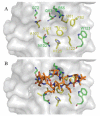Structural mechanisms of cyclophilin D-dependent control of the mitochondrial permeability transition pore
- PMID: 25445707
- PMCID: PMC4430462
- DOI: 10.1016/j.bbagen.2014.11.009
Structural mechanisms of cyclophilin D-dependent control of the mitochondrial permeability transition pore
Abstract
Background: Opening of the mitochondrial permeability transition pore is the underlying cause of cellular dysfunction during diverse pathological situations. Although this bioenergetic entity has been studied extensively, its molecular componentry is constantly debated. Cyclophilin D is the only universally accepted modulator of this channel and its selective ligands have been proposed as therapeutic agents with the potential to regulate pore opening during disease.
Scope of review: This review aims to recapitulate known molecular determinants necessary for Cyclophilin D activity regulation and binding to proposed pore constituents thereby regulating the mitochondrial permeability transition pore.
Major conclusions: While the main target of Cyclophilin D is still a matter of further research, permeability transition is finely regulated by post-translational modifications of this isomerase and its catalytic activity facilitates pore opening.
General significance: Complete elucidation of the molecular determinants required for Cyclophilin D-mediated control of the mitochondrial permeability transition pore will allow the rational design of therapies aiming to control disease phenotypes associated with the occurrence of this unselective channel. This article is part of a Special Issue entitled Proline-directed Foldases: Cell Signaling Catalysts and Drug Targets.
Keywords: Cyclophilin-D; Mitochondrial permeability transition; Peptidyl-prolyl cis-trans isomerase.
Copyright © 2014 Elsevier B.V. All rights reserved.
Figures




References
-
- Bernardi P, Krauskopf A, Basso E, Petronilli V, Blachly-Dyson E, Di Lisa F, Forte MA. The mitochondrial permeability transition from in vitro artifact to disease target. FEBS J. 2006;273:2077–2099. - PubMed
-
- Hunter DR, Haworth RA, Southard JH. Relationship between configuration, function, and permeability in calcium-treated mitochondria. J. Biol. Chem. 1976;251:5069–5077. - PubMed
-
- Hunter DR, Haworth RA. The Ca2+-induced membrane transition in mitochondria I The protective mechanisms. Arch. Biochem. Biophys. 1979;195:453–459. - PubMed
-
- Haworth RA, Hunter DR. The Ca2+-induced membrane transition in mitochondria II Nature of the Ca2+ trigger site. Arch. Biochem. Biophys. 1979;195:460–467. - PubMed
-
- Hunter DR, Haworth RA. The Ca2+-induced membrane transition in mitochondria III Transitional Ca2+ release. Arch. Biochem. Biophys. 1979;195:468–477. - PubMed
Publication types
MeSH terms
Substances
Grants and funding
LinkOut - more resources
Full Text Sources
Other Literature Sources
Research Materials

